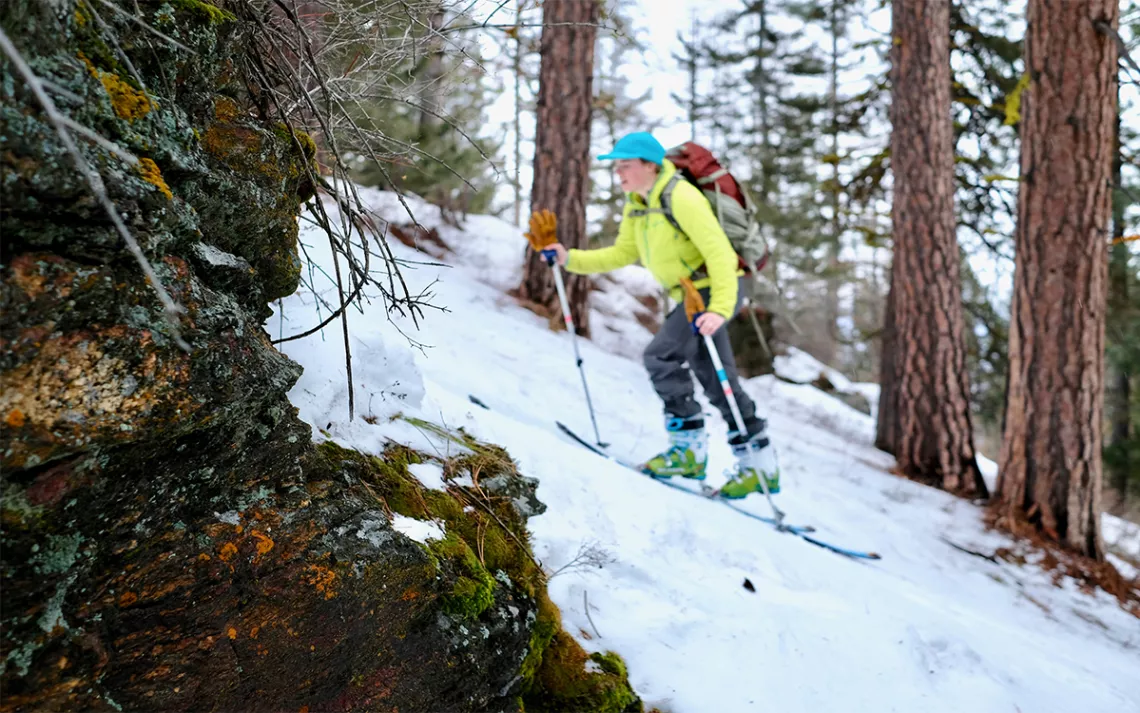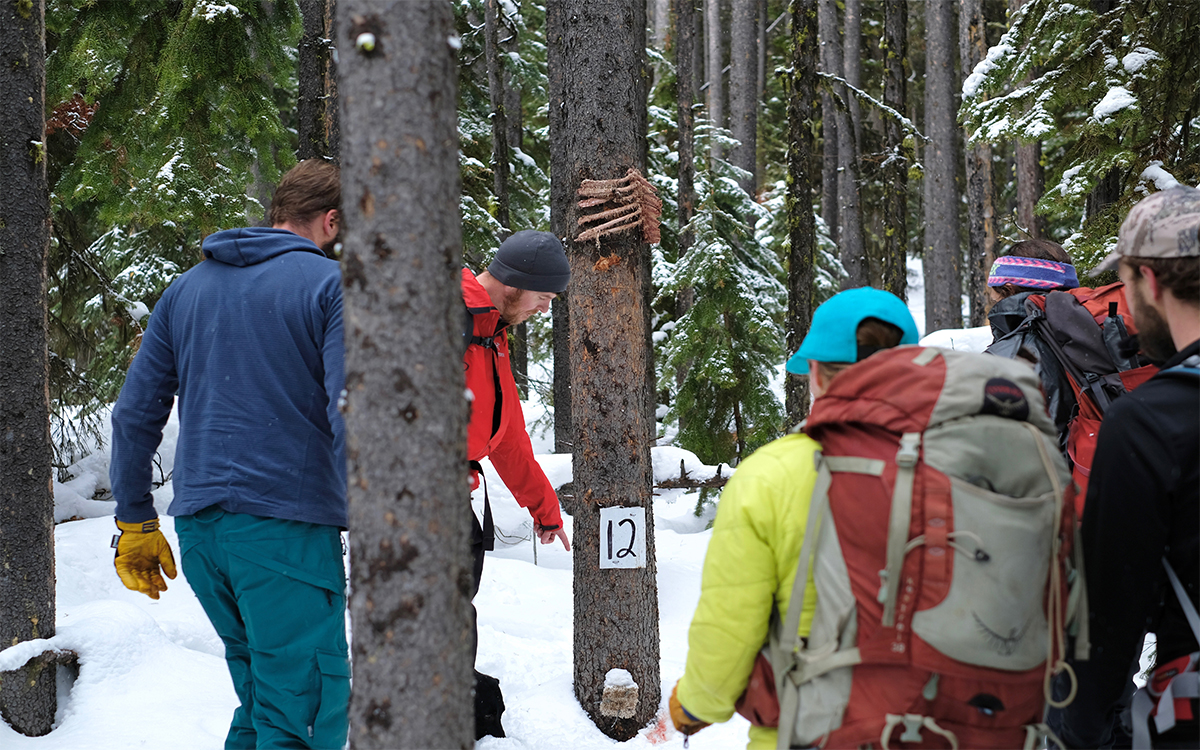Citizen Scientists on Skis Work to Save Wolverines
Wolverines need snow. We need data to help protect them.

Photos courtesy of Will Schreck
A call comes in, and Russ Talmo, a wildlife biologist with the Defenders of Wildlife, hops in his pickup and heads down U.S. Highway 93. He scans the shoulder, and at last, on the side of the road, he spots what he is looking for: roadkill. He needs it for bait.
Talmo is one of the project leads for Wolverine Watchers, an initiative in western Montana that is studying wolverines. It is estimated that there are fewer than 300 in the lower 48 states, making it an exceedingly rare and imperiled species. The project also studies other rare mesocarnivores like lynx, martens, and fishers.
By setting bait at monitoring stations equipped with camera traps and gun brushes, Wolverine Watchers uses noninvasive methods to collect data on the presence of mesocarnivores in one of their key areas of remaining habitat, Montana’s Bitterroot Range. The Bitterroot National Forest spans 1.6 million acres in southwest Montana and Idaho, but the Forest Service can afford to employ only two technicians to seasonally monitor these species.
Volunteers from Wolverine Watchers help fill the gap. The project, now in its fourth year, is a collaboration between conservation nonprofits and government agencies, but what makes it truly remarkable is the involvement of more than 150 citizen scientists, ages seven to 70. “The project wouldn’t be possible without them,” Talmo says. With the assistance of staff from the Defenders of Wildlife and MPG ranch, the volunteer teams set up and collect data from 25 monitoring stations in the northern portion of the range, and the project continues to grow.
Wolverine Watchers have been most successful locating wolverines at higher-elevation sites, places that are often difficult to access in the winter. For the 2017–18 field season, Wolverine Watchers proposed a new monitoring site on the flanks of a peak called Little St. Joe, and last December, I joined a small group of volunteers to backcountry ski into the site and set up the monitoring station in hopes of glimpsing one of these rare animals.
It was a cold morning. The sky was low and gray. The snowpack was not yet deep enough to ski, so we trudged up the ridge, hauling in the game camera and the bait. At around 6,000 feet of elevation, we punched through the inversion and emerged into a bright, bluebird day. Below us stretched the valley, filled with fog. It resembled a lake, and the peaks of the Bitterroots and Sapphires poked through like islands.
Those peaks are islands in another sense, too—they're isolated habitat. In the Rockies, wolverines depend on high-elevation snowpack for survival. They den at or near the tree line, in high alpine cirques, and according to Wolverine Watchers co-project-lead Kylie Paul, “There is no denying that wolverines den with snow.” Nearly every den that has been located was found in deep snowpack, and the science is clear that our snow is disappearing.
During the last 30 years, snowpack in the Rocky Mountain west has shrunk at a rapid pace. According to a study by Greg Pederson of the USGS Northern Rocky Mountain Research Center, the decline has been “almost unprecedented” over the last 800 years. Pederson’s team attributes the decline to warmer springtime temperatures. Some of this is caused by natural climate variation, but rising greenhouse gas levels are a permanent game changer. Earlier eras of warm temperatures in the Northern Rockies were followed by cool periods. This time, researchers do not expect the cold to return.

None of this was news to our group of volunteers. But it is one thing to know about climate change; it is another to see its strange signature etched on the land. As we neared the site, our team lead, Simon Buzzard, noticed an unnatural, red powder on the trees. It was fire retardant. During the previous summer, the Lolo Peak Fire burned more than 500,000 acres in the drainage to the north. Recent studies have shown how climate change is altering wildfires, too, increasing the intensity of the burns and the length of fire season. The retardant, which is toxic to fish, would soon wash into the Bitterroot River, one of the west’s great trout fisheries. The red dye was like a tracer, helping us glimpse the subtle interconnectedness of things—and the pervasive, systemic effect of climate change.
Like so much else, the wolverine is caught in the politics around climate change. In 2013, the U.S. Fish and Wildlife Service proposed listing the animal as threatened under the Endangered Species Act, saying, “climate warming over the next century is likely to significantly reduce wolverine habitat.” In a surprising about-face, the agency reversed its position a year later, but a federal judge ordered it to reconsider the species for listing, arguing that the agency had come to the decision in part due to “immense political pressure.” A final ruling on the wolverine’s status is expected sometime in 2018, and new studies on wolverines and snowpack may determine the outcome.
The data collected by Wolverine Watchers will not contribute directly to the USFWS’s decision to list, but it does inform management decisions made on the local level. The project is also building a constituency of engaged and informed citizens who care about the future of the species.
“It’s fun to be out skiing with friends and have an additional purpose, to know your part of this bigger project,” Buzzard says. “I like the challenge of moving through the mountains on skis. The animals are still up there, but the people aren’t. It’s almost like winter brings me closer to them.”

At the site, we hung the bait in the tree, set up gun brushes to snag hair for DNA samples, and armed the game camera. A month later, we returned. The snowpack was a little deeper, and we were able to ski up the ridge. The first thing we noticed at the site was that the bait was gone. Something had ripped it off the tree. We clicked through the photos from the game camera. It was a mountain lion. It had been there only a few hours earlier, and there was a good chance that it was hidden somewhere nearby, watching us.
It was a thrill to see photos of the big cat, but to our disappointment, no wolverines had been to the site. We finished up our work, re-baiting the station and recording our data. The snow had begun to soften in the warm air. On the ski out, we took long, sweeping turns. The skiing gave me a sense of weightlessness and freedom—then the snowpack grew thin. The rocks began to jolt us through our skis, and at last, we had no choice but to walk out.
In its elusiveness and the extremes of its habitat, the wolverine is a rarified symbol of the wild, of what remains of it. Back at the car, I consoled myself with the thought that we still might glimpse one, but the larger question is for how much longer?
 The Magazine of The Sierra Club
The Magazine of The Sierra Club



